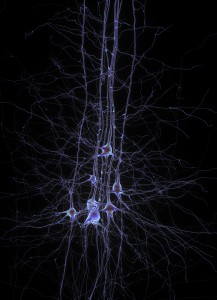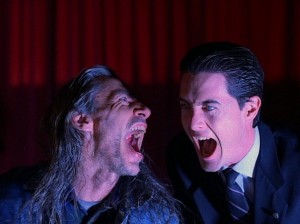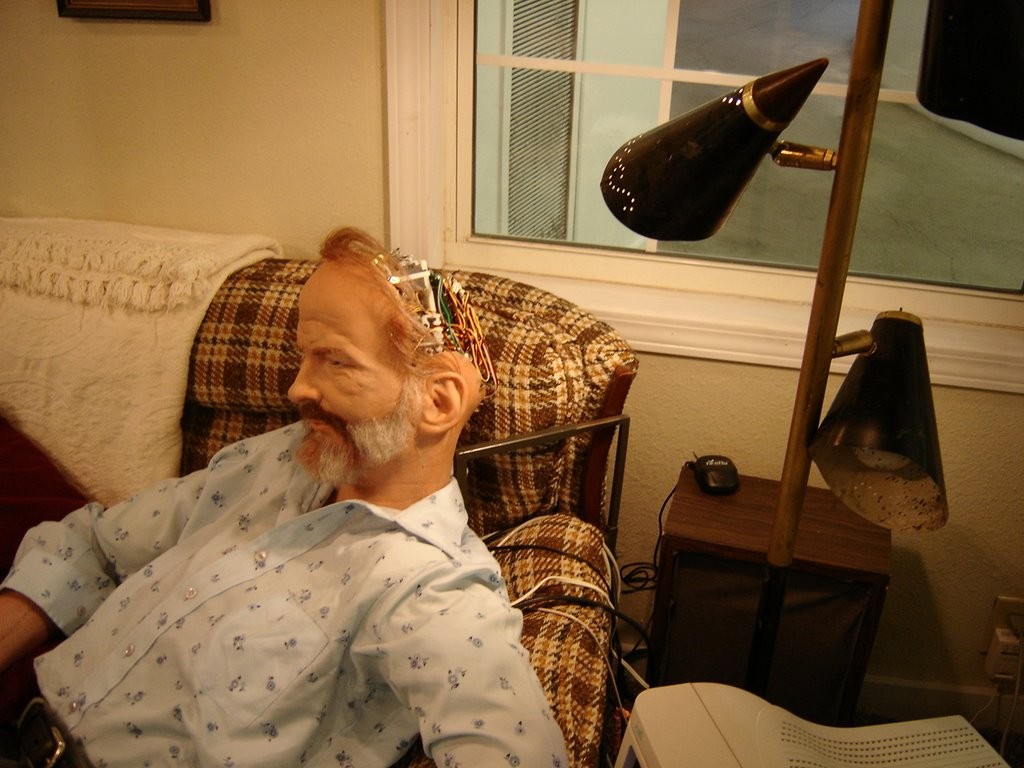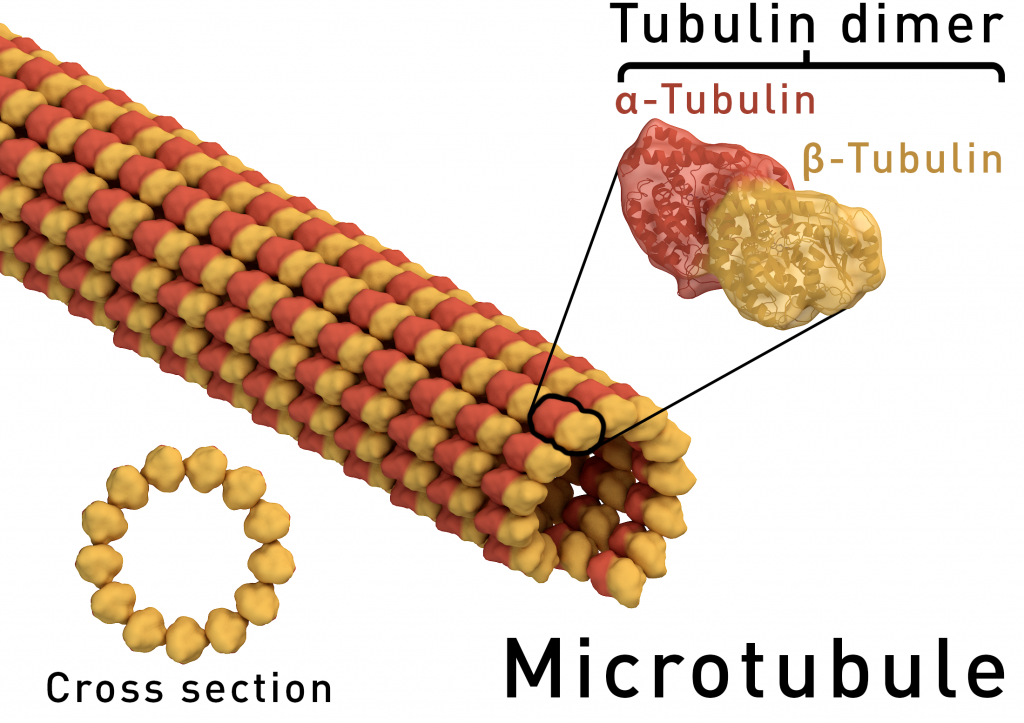The Phil Dick Circuit and the Future of Precognitive Technology
Much of the skepticism surrounding quantum neuroscience is that its aim is generally to explain consciousness—a tall, confused, and some would say impossibly misguided order. Quantum explanations for consciousness invariably require large-scale coherence—that is, entanglement—across the whole brain or at least between large populations of neurons. Quantum wet blankets point out that this can only be hand-waving and magic. And anti-materialists would say that no scientific account, no matter how quantum-y, is going to explain the subjective experience of being alive and aware.
I’d bet money that select neurons deep within specific circuits of the brain are going to turn out to be finely tuned time machines that fire before they are stimulated.
But as I’ve already argued, even if we know they are chasing a red herring, we should actively encourage Roger Penrose and others who are hunting for elusive consciousness in the quantum behavior of neurons and neural circuits. This is because a beneficial side-effect of that effort is that it is going to bring an explanation of the more philosophically humble but also more exciting phenomenon, psi.
Psi is exciting because it means precognition, time-traveling information. That should make people poop their pants with wonder and forget about boring old consciousness. Precognition is mind-bending, and it is not some vague airy effect of “nonlocality.” If I’m right, it is specifically sensitivity to our own responses to future stimuli, which means it is extremely local, in the sense of personal, like memory, and thus certainly involves brain processes. We now know that information can be sent back in time, and Seth Lloyd has shown how to do it (theoretically anyway). It involves entanglement, but not the long-distance entanglement between neurons that most offends quantum critics. If it can happen, nature will find a way, and those microtubules inside neurons that fascinate Penrose et al appear to be the best place in nature for it to occur.*
I’d bet money that select, as-yet undiscovered neurons deep within specific circuits of the brain are going to turn out to be finely tuned time machines that fire before they are stimulated. Serial entanglement of particles within or between the neuron’s microtubules over a short span of time would be involved. Particles traveling up and down a neuron’s axon through those tubes “just” need to break their prior entanglements and be re-entangled (sending information back in time), and this “just” needs to perturb the neuron’s behavior by even a tiny amount. I trust there are people working on the nitty gritty of this problem.
 When you string multiple time-displaced neurons together, you can multiply the time-displacement effect. For instance, even if the net result of the various quantum shenanigans in a given neuron’s microstructures is that it fires off neurotransmitters to the next neuron just a hundredth of a second before it receives an input via its dendrites—a modest request—a string of twenty such neurons would produce an “output” (e.g., a motor or autonomic response) a fifth of a second before the stimulus. That’s enough to account for the delay Benjamin Libet famously noted between the neural readiness potential and the feeling of conscious will, which some wet blanket types like to wave before our eyes as proof that consciousness in an illusion.
When you string multiple time-displaced neurons together, you can multiply the time-displacement effect. For instance, even if the net result of the various quantum shenanigans in a given neuron’s microstructures is that it fires off neurotransmitters to the next neuron just a hundredth of a second before it receives an input via its dendrites—a modest request—a string of twenty such neurons would produce an “output” (e.g., a motor or autonomic response) a fifth of a second before the stimulus. That’s enough to account for the delay Benjamin Libet famously noted between the neural readiness potential and the feeling of conscious will, which some wet blanket types like to wave before our eyes as proof that consciousness in an illusion.
Fifty such neurons would give you a whole half-second “pre-sponse”—enough to account for the subjective timing discrepancy between seeing your foot hit the ground and feeling it hit the ground, noticed by Libet back in the late 1970s. A hundred such neurons in a circuit would give you a full second advance warning of events, useful on the highway, the battlefield, or the racquetball court. Three hundred would be sufficient for effects seen in many presentiment experiments conducted by Dean Radin and Daryl Bem.
There are a hundred billion neurons in the brain, and thus there could be any number of precognitive circuits or clusters of neurons in there, “tuned” to specific temporal distances that are sweet spots for certain adaptive responses or functions like subjective timing, conscious will, and James Carpenter’s “first sight,” not to mention premonitions of more remote events. I hope they name a particularly long one the Phil Dick Circuit, because such a neural mechanism would go a long way to explain the world he described in his writings.
The Skynet Is (Not) the Limit
So here’s a business model for a forward-thinking biotech company: Isolate the most precognitive neuron you can find in the animal kingdom, perhaps from an elephant or whale—something involved in synchronizing a large animal’s sense of self—and find a way to sustain a group of such neurons in culture. You could create a nice little precognitive alarm by chaining such neurons together. A chain of 1000 neurons, each of which fire, say, 20 milliseconds before they are stimulated, would produce a device that triggers about 20 seconds before a designated input. (This may be an easier and faster route than trying to build a mechanical quantum computer from scratch, given the extreme refrigeration requirements, etc.)
The challenge of precognitive technology is working within the narrow margin where information tends not to be self-cancelling.
Then, assemble several of these devices in a petri dish, and set the first neuron in each chain to respond to a downward change in the value of one of your stocks, triggering a “sell” as the output of the chain. I don’t have much of a head for such things, but you get the picture. Do it quietly, though, and amass your fortune quickly, because sooner or later a branch of the SEC will be established to prevent precognitive trading. (No doubt there will be telltale signs of such stunts, such as a tendency of company or an individual mad-scientist investor to drop shares in a stock just seconds before a downturn in value.)
Or you could just buy shares in a quantum computing company like D-Wave, because they are surely going to do something like this once it occurs to them … or it probably already has occurred to them. Such a scheme could, for all I know, be a big secret dream in the emerging quantum tech biz.
 I’m not completely kidding. I’m not an engineer, so I admittedly don’t have a sense of the technical hurdles, but as far as I can tell it “just” needs to be scaled up from what has already been accomplished at very micro scales in laboratories … or, again, from what select undiscovered neurons are doing right now in your own head. I imagine precognitive tech could be huge in the mid-21st century; the possibilities would be mind-blowing, not to mention highly destabilizing. The very first obvious application would be in financial trading, but a natural next step would be pairing artificial precognition with AI, which could be beyond scary. (FYI, just last month, D-Wave announced a multi-year contract with Lockheed-Martin. Skynet, anyone?) But precognitive chips could also have wide beneficial applications and revolutionize safety features in vehicles and security systems, not to mention healthcare. They might also provide the needed failsafes against those scary precognitive AIs.
I’m not completely kidding. I’m not an engineer, so I admittedly don’t have a sense of the technical hurdles, but as far as I can tell it “just” needs to be scaled up from what has already been accomplished at very micro scales in laboratories … or, again, from what select undiscovered neurons are doing right now in your own head. I imagine precognitive tech could be huge in the mid-21st century; the possibilities would be mind-blowing, not to mention highly destabilizing. The very first obvious application would be in financial trading, but a natural next step would be pairing artificial precognition with AI, which could be beyond scary. (FYI, just last month, D-Wave announced a multi-year contract with Lockheed-Martin. Skynet, anyone?) But precognitive chips could also have wide beneficial applications and revolutionize safety features in vehicles and security systems, not to mention healthcare. They might also provide the needed failsafes against those scary precognitive AIs.
Although it may seem like it, the sky is not the limit with precognition, synthetic or natural. The challenge of precognitive technology is working within the narrow margin where information tends not to be self-cancelling—this is the parameter of “post-selection” that is required by a Seth-Lloyd-style quantum time machine: You can’t build a system whose (prior) output leads to a chain of events that prevents its (subsequent) input. Fiction about time travel has failed to incorporate this crucial parameter, and as a result has given rise to all the comedy of grandfather paradoxes, etc. In reality, there wouldn’t be such problems because of the constraints within which information sent back in time can actually be readable and not noise. Quantum computers are actually analog computers, not digital; reality is analog too. Quantum computers and quantum time travel operate, if I understand correctly, on a signal-to-noise ratio—just as I have argued human precognition operates.
The vagaries of the analog universe are what forever prevent us from using the existence of precognition to answer questions about free will versus determinism. There is always wiggle room and uncertainty. These vagaries also set interesting constraints on the precognitive chips that might one day be at the heart of our devices and computers. They can only give us advance warning of certainties we can do nothing to prevent.
Precognitive Chips
As a thought experiment, imagine a precognitive computer chip inside your security system, tripped when unauthorized entry is detected. How much pre-warning could it give of a home intrusion?
Causality in an analog universe never contradicts the possible, but information is buried deeply in noise; we can never know for certain what information actually comes from the future
For any given application of precognitive tech, there would probably be a sweet spot—an optimal temporal distance between output and input within which the system tends to work reliably without noise exceeding signal. So for instance, an alarm system set to notify the police station 15 minutes before a break-in would not be viable and would literally not provide useful information; the reason is that 15 minutes is too much time, and would theoretically allow the police to be on the scene in advance and scare off anyone with malicious intent; in reality, the alarm would never go off except in cases when there was a break-in and the police were for some reason unable or unwilling to respond in time to prevent it. False alarms would tend to increase the more the alarms were ignored—too much noise to signal, resulting in a feedback loop, because they would be taken less and less seriously…
 It would be a highly dysfunctional chip, in other words. But the alarm manufacturer would never make such an alarm in the first place. (Makes you wonder if car alarms use such chips, since it seems the more we ignore them, the more they are tripped.)
It would be a highly dysfunctional chip, in other words. But the alarm manufacturer would never make such an alarm in the first place. (Makes you wonder if car alarms use such chips, since it seems the more we ignore them, the more they are tripped.)
For a home security system, I can imagine that a three-minute pre-lay might be more in the right ballpark. This might be enough time for the police to be en route to the scene and nab the burglar but not enough time for them to prevent the break-in that trips the alarm. In that case, the alarm would work more reliably; just after the burglar got in and tripped the alarm, he’d hear sirens approaching.
The same principle could be applied to vehicle safety devices: You could not have a precognitive system in a car that reliably warned you five seconds before a collision, because you or the car’s computer driver could avoid the collision with that kind of warning, nullifying the chip’s effectiveness. You could however have a precognitive system that responded to a non-avoidable collision half a second into the future. This could be useful, for instance, in pre-triggering airbags and other safety features to protect the vehicle’s occupants. Or, in a jet fighter—if there are still human pilots in jet fighters when this becomes possible—you could have an ejector seat triggered by a precognitive sensor half a second before a missile strike (but, again, not one that gave the pilot sufficient time to evade or destroy the threat with a countermeasure).
And there’s medical devices: For instance, medical sensors to detect an imminent heart attack. Again, a bio-chip could not alert you to an adverse event that was preventable through your actions (like popping an aspirin), but it could trigger an emergency response and perhaps pre-initiate measures to mitigate the harm or tissue damage and prevent death.
Those are just a few ideas that come to mind. The applications in cybersecurity and cyberwarfare, of course, are intimidating (and bewildering) to think about. But again, they wouldn’t enable anyone (or even any AI) to fully manipulate reality, just game it or leverage it in interesting ways.
The Safety Zone
To me, this narrow band within which precognition’s effects are actionable and useful is the really interesting thing about it. Most precognitive effects, especially when they enter consciousness at all, such as in dreams, are only visible after the fact. It needs to be that way, because enhanced consciousness of future events would result in us taking “evasive action,” even inadvertently, so the farther out in the future a precognitively portended event, the more we will tend to encounter the information obliquely, associatively, “synchronistically,” or otherwise in a way that facilitates our misinterpreting or ignoring it until too late.
Precognition is built around reward and enjoyment, not trauma and pain. Post-selection explains why positive signals of reward are preferentially “pre-ceived.”
In the comments to my last post, a reader asked an excellent question, which goes to the heart of this problem: What if you have a dream that you’re going to die in a car accident so you take a bus instead, and nothing happens? From what future could the idea “you’re going to die in a car accident” have been sent? The answer is going to seem evasive: How do you know it was ever a premonition? How do you know that information was sent from the future? You have no way of reliably saying so until it “comes true.” So it’s wrong to say it was a premonition; it may have felt premonitory, but we have hunches all the time that prove wrong. Our metacognition—knowledge of where a piece of information comes from—is often distorted or imperfect. This is as true of precognition as it is of memory (and they will both probably turn out to be the same thing).
 Causality in an analog universe never contradicts the possible, but information is buried deeply in noise; we can never know for certain what information actually comes from the future, or even its “accuracy” (i.e., correspondence to future events) beforehand. The confirmation scene, when some prior hunch matches a real event, is a crucial part of the process, and this must happen in the ordinary workaday flow of linear time.
Causality in an analog universe never contradicts the possible, but information is buried deeply in noise; we can never know for certain what information actually comes from the future, or even its “accuracy” (i.e., correspondence to future events) beforehand. The confirmation scene, when some prior hunch matches a real event, is a crucial part of the process, and this must happen in the ordinary workaday flow of linear time.
Hacking the system is possible, but within narrow parameters. An elaborate associative remote viewing setup, for example, can be used to play the stock market, as Russell Targ proved in 1982 with his successful adventure in silver futures trading. But you can’t just, by yourself, rub your temples and see straight-on what’s going to happen in the future; it just doesn’t work that way, because it can’t. There are good reasons evolution hasn’t made us all massively precognitive supermen and -women; even apart from the peculiarities of post-selection, there would be adaptive reasons for a biological system to keep precognition within strict limits and mostly unconscious.
Fire, Walk With Me
Precognition is built around reward and enjoyment, not trauma and pain. Post-selection explains why positive signals of reward are preferentially “pre-ceived”: Reward circuits would be precognitive, because we will orient toward future pleasures, and thus tend to produce the action that results in the pleasure that sends a signal back in time. This is the primary reason why I think dopamine and the brain’s reward circuitry will turn out to have an important connection to those precognitive neuronal ensembles. This is the system that keeps us focused on “the next thing,” drawing our interest to pleasure as well as survival-relevant information.
There is nothing particularly “moral” about psi. Instead of binding us to other people across space, psi binds us to ourselves in the future, and to our own relief or pleasure within the larger context of threat and danger.
Pain traveling into the past, on the other hand, would lead the organism to take a course of action that leads to the avoidance of the stimulus that caused it, thus such a circuit would not be reliable, would violate the rules of post-selection, and would be selected against. Even as a survival tool, precognition will be oriented toward relief from threat or punishment, not the threat or punishment itself. I have noticed in my own case, for example, that precognitive dreams occur most around changes in emotion, from frustration to gratification.
Why then is the precognitive signal so strong around other people’s pain and suffering—the observation that led Fredric Myers to believe that trauma “powered” psychic phenomena? The answer is jouissance, the binding of pleasure to pain, including the intense sublime awe at surviving disasters that befall other people. Precognition may in fact be the very reason for jouissance, the very reason we get excited about destruction, fire, and death, especially when these things happen to others. Jouissance was Jacques Lacan’s answer to Freud’s concept of the “death drive,” which seemed paradoxical because Freud couldn’t see how it would be adaptive to be drawn to death. We’re not really drawn to death, but we are necessarily fascinated by death and pain as long as we can extract some personal reward from it.
 When I think of jouissance in the context of psi, I think of “Bob” and his demon-spirit friends in Twin Peaks’ Black Lodge, who seem to personify our necessary and terrifying dark side, the hunger for others’ pain and suffering, or “Garmonbozia.” David Lynch is deeply keyed into this nexus of psi and occult forces, which probably has its roots in our most basic and ancient survival needs.
When I think of jouissance in the context of psi, I think of “Bob” and his demon-spirit friends in Twin Peaks’ Black Lodge, who seem to personify our necessary and terrifying dark side, the hunger for others’ pain and suffering, or “Garmonbozia.” David Lynch is deeply keyed into this nexus of psi and occult forces, which probably has its roots in our most basic and ancient survival needs.
So psi (as precognition) is a system that orients us to threats by making threat-vigillance and the threat response rewarding. Here’s where I disagree slightly with Myers, or Jeffrey Kripal: There is nothing particularly “moral” about psi, at least not directly. Instead of binding us to other people across space, psi binds us to ourselves across time, specifically to our own relief or pleasure within the larger context of life’s perils and pains. Yet I think a major positive byproduct of psi is that it orients us, unconsciously, to rewarding (or relieving) future scenes of connection to other people IRL, in real life. Unconsciously, it pulls us toward eros and the good. This is because it is with and among others that our more mundane, linear-in-time, classical brains take conventional pleasure and respite from those perils and pains.
NOTE
* Here’s a fun microtubule fact: The ancestors of the microtubules in your cells were spirochetes back in the primordial soup days of the early Earth. They were eventually engulfed as endosymbiotes within other bacteria, to make the more complex cells that build the macro-sized beings of our world. So in other words, the billions of mini time machines in your brain right now share a common ancestor with syphilis.** You’re welcome.
FRACTAL NOTE WITHIN A NOTE (added 12/5/15)
** A reader has helpfully alerted me that, despite decades of searching, Lynn Margulis has been unable to support her hypothesis that microtubules descended from engulfed spirochetes. So that idea, however cool, is probably not true. We can’t have everything.







This has been a very engaging set of posts.
One of the first, if not the first, posts I read by you was your argument against the Minkowski glass-football universe. In one of your more recent posts, you mentioned that you have been swinging back in the other direction. In light of this current post, I’m curious about just how far you’ve swung?